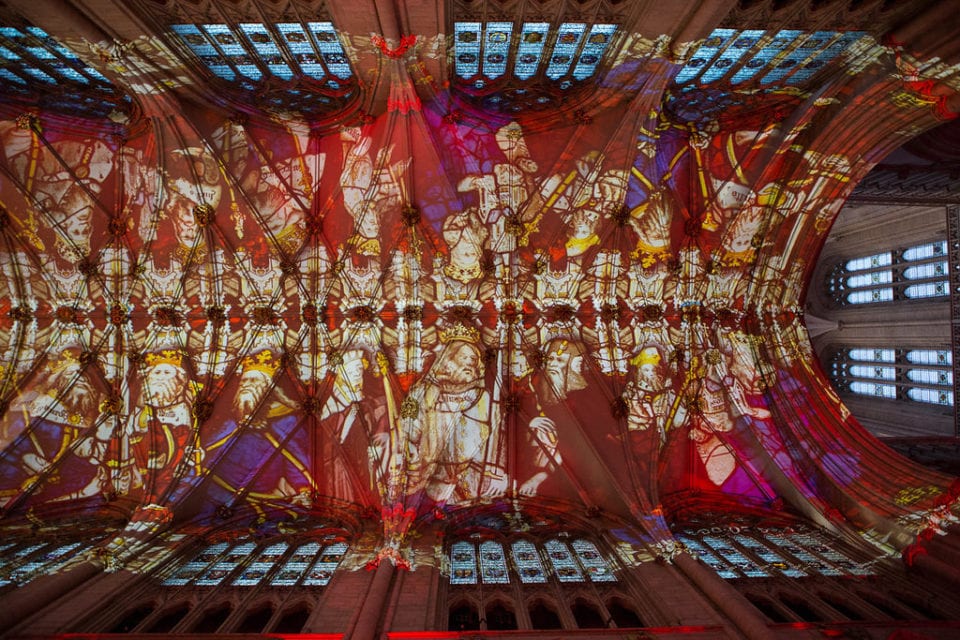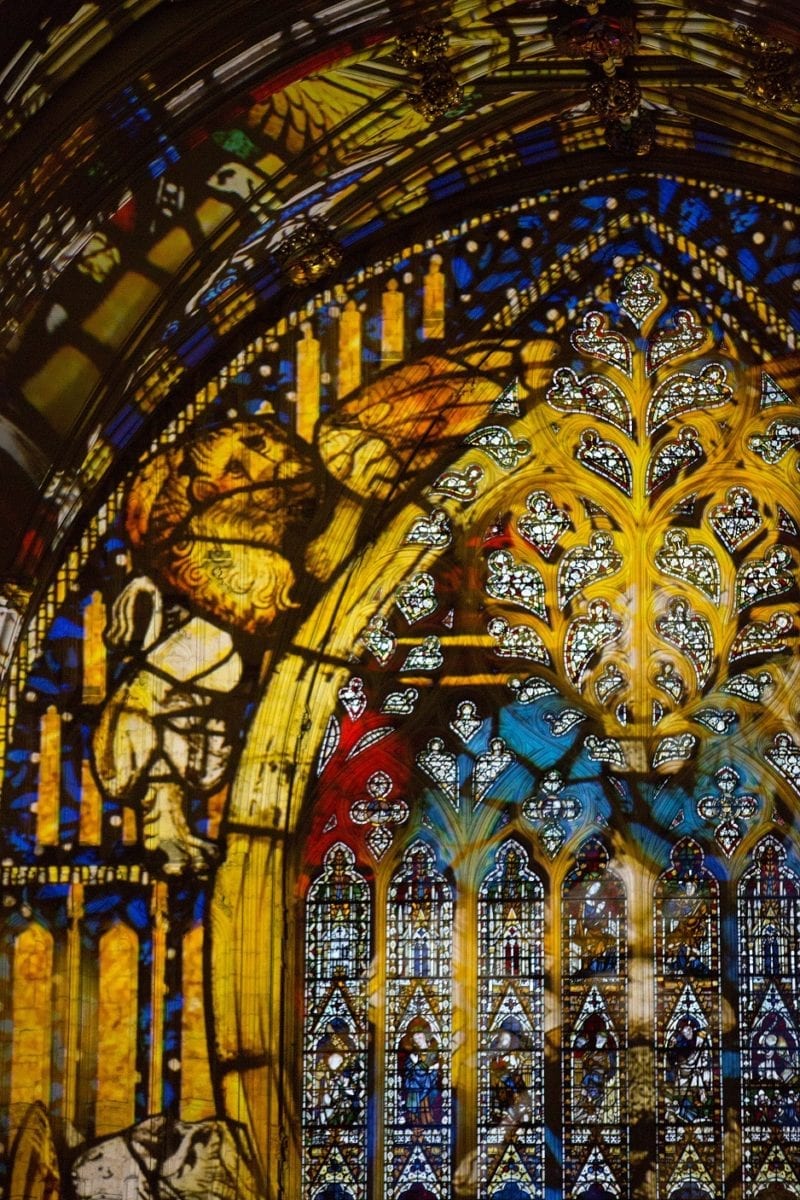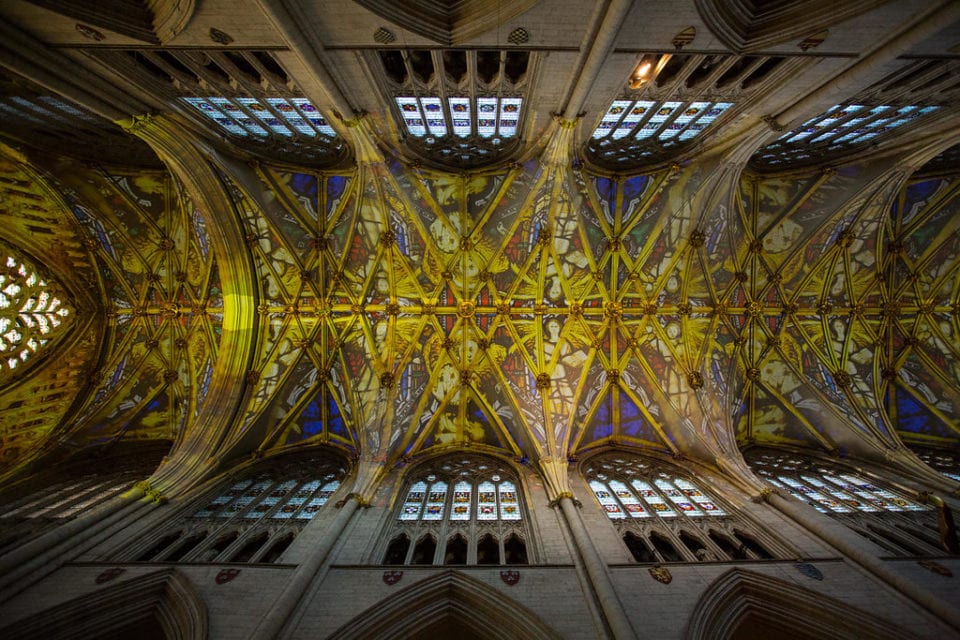The iconic architecture of York Minster is transformed by Northern Lights – a sound and light installation from The Projection Studio. Artists Ross Ashton and Karen Monid discuss their influences, exploring how the piece unites past and present.
A: What aspects of York Minster’s medieval stained glass and architecture inspired you?
RA: York Minster is a masterwork of medieval creativity. Both the architecture and the stained glass are the pinnacle of artistic expression at the time. The Great East Window is a unique medieval representation in glass of the entire cosmos, from creation to the biblical apocalypse. Created by John Thornton, the scale of this work is breath-taking, and each panel of the East Window is an artwork in its own right. Due to the vast scale of the window, they are not easily seen by the public. We are able to deconstruct details of the glass and through projection use those to transform the nave vault, reinterpreting the architecture of the nave.
A: How have you translated these historic designs into a sound and light installation? What technologies are used in this process?
RA: The creation of digital visual art is a three-stage process. I began with a laser scan of the interior spaces from which we constructed a three dimensional ‘map’ of the architecture.
Then I design the images onto this 3D map. As this is then used as the template for the projection in virtual space, we can be sure that the projected images will fit perfectly back onto the architecture in the real world. Using this technique, I was able to reconstruct the nave architecture using elements drawn from the stained glass.
KM: The sound design is rooted in the history of York. I built the sound from a number of texts written between the 7th and 14th century that draw on themes of light, the apocalypse and Viking poetry. I used the original languages they were written in – Latin, Old Norse and Old English as well as modern English. The voice recordings were interwoven and layered with beautiful singing performances by the York Minster Choir to create multichannel surround sound in the nave.
A: How does Northern Lights create dialogues between medieval and contemporary art?
RA: We wanted this piece to be a modern descendant of the medieval traditions of working with colour in paint and glass. We were drawn to the medieval idea that light, and its interaction with coloured glass, is a metaphor for the eternal power of the divine. Using projected light as the medium with which to ‘repaint’ the architecture allowed us to combine both these forms into one.
A: What themes does the piece explore?
KM: Right now, there is an increase in concern about climate change and the earth becoming uninhabitable for humans. Considering what possible endings humanity might face is not new. Northern Lights draws inspiration from the medieval viewpoint on this, juxtaposing the biblical apocalypse with Ragnarok from Viking culture.
RA: As artists we are fascinated by humanity’s attempts to understand the universe and our place in it. People are always looking for answers to the same basic questions: “Who are we?”, “Where did we come from?”, “Where are we going?”. Though the answers have changed through time, the questions are always the same. Northern Lights is our response to the way these questions are asked and answered within this place.
A: How does the sound complement the experience?
KM: For us, sound is an equal partner in the work beside the visual aspects. We often work from the sound first, giving it a primacy in the creative process. The surround sound here is very much like a ‘tapestry’, specially built for the Minster. It brings a three-dimensional immersive quality to the piece through the music, voices and effects and really evokes a feeling of the depth of time that the Minster’s represents.
A: What do you hope audiences take away from the show?
KM: People do not often experience the same sense of awe that would have been the case for a medieval person experiencing a cathedral. The conscious use of light and colour in cathedral building has been written of in medieval philosophy, theology and science, and indeed some of these writings feature in the work. We know about the effect it was meant to create for human beings. We wanted to use current technology to bring that experience to people through a 21st century response to the space.
A: What projects do you have lined up for 2020?
RA: We are curators and co-directors of the Napa Lighted Art Festival for contemporary light art which takes place in California in January 2020. In February 2020 we are presenting new works at Light Up Poole and Cheriton Light Festival and later in the year we will be creating works for Lincoln and St Edmundsbury Cathedrals as part of the Year of Cathedrals.
24-31 October. Find out more here.
All images courtesy Duncan Lomax, Ravage Productions.








